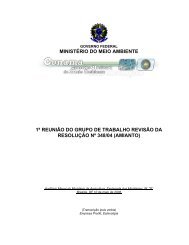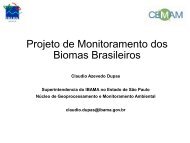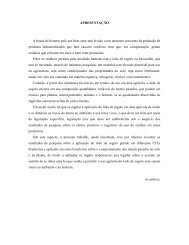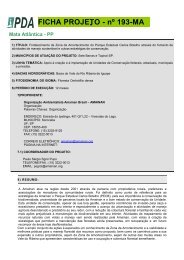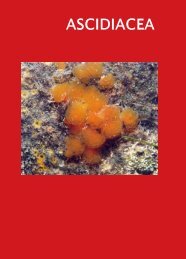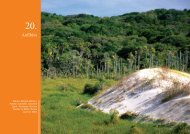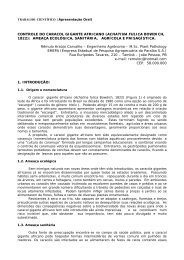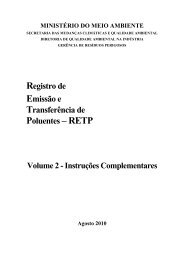Effects of Future Infrastructure Development on Threat Status and ...
Effects of Future Infrastructure Development on Threat Status and ...
Effects of Future Infrastructure Development on Threat Status and ...
You also want an ePaper? Increase the reach of your titles
YUMPU automatically turns print PDFs into web optimized ePapers that Google loves.
2 Predicting Bird <strong>Status</strong> in the Amaz<strong>on</strong><br />
Palabras Clave: Amaz<strong>on</strong>ía, aves amazónicas, ecoregi<strong>on</strong>es, endemismo, estatus de amenaza, deforestación,<br />
desarrollo de infraestructura, llanuras inundables, pérdida de hábitat<br />
Introducti<strong>on</strong><br />
The Amaz<strong>on</strong> rainforest (hereafter Amaz<strong>on</strong>ia) is unmatched<br />
in its extent <strong>and</strong> biodiversity. It is also losing forest<br />
rapidly. Moreover, Brazil—with 60% <str<strong>on</strong>g>of</str<strong>on</strong>g> Amaz<strong>on</strong>ia—is<br />
implementing a wide array <str<strong>on</strong>g>of</str<strong>on</strong>g> infrastructure projects in<br />
the regi<strong>on</strong>. Several researchers forecast a measurable<br />
increase in the already high rates <str<strong>on</strong>g>of</str<strong>on</strong>g> deforestati<strong>on</strong> <strong>and</strong><br />
increased CO2 emissi<strong>on</strong>s if these projects are fully implemented<br />
(e.g., Laurance et al. 2001; Nepstad et al. 2001;<br />
Soares-Filho et al. 2006). Few researchers, however, have<br />
looked at the possible c<strong>on</strong>sequences <str<strong>on</strong>g>of</str<strong>on</strong>g> Amaz<strong>on</strong>ian infrastructure<br />
development to the area’s excepti<strong>on</strong>al biodiversity,<br />
<strong>and</strong> no <strong>on</strong>e has predicted which species might<br />
be at risk. We filled this gap for <strong>on</strong>e <str<strong>on</strong>g>of</str<strong>on</strong>g> the best-known<br />
taxa: birds. To do this, we documented 2 things: where<br />
the species are found (in particular, where the species<br />
most vulnerable to extincti<strong>on</strong> are found) <strong>and</strong> where infrastructure<br />
development is planned. The areas where<br />
high c<strong>on</strong>centrati<strong>on</strong>s <str<strong>on</strong>g>of</str<strong>on</strong>g> species <strong>and</strong> development overlap<br />
are where species will be at risk.<br />
Where Species Occur<br />
According to the maps <str<strong>on</strong>g>of</str<strong>on</strong>g> Ridgely et al. (2003), Amaz<strong>on</strong>ia<br />
(as defined by ecoregi<strong>on</strong>s) holds 1778 native birds,<br />
627 mammals, <strong>and</strong> 527 amphibians, or <strong>on</strong>e-sixth <str<strong>on</strong>g>of</str<strong>on</strong>g> the<br />
world’s totals <strong>on</strong> average. The Brazilian Amaz<strong>on</strong> al<strong>on</strong>e<br />
holds 1169 birds, or approximately 12% <str<strong>on</strong>g>of</str<strong>on</strong>g> the world’s<br />
birds. Although we examined how development in the<br />
Brazilian Amaz<strong>on</strong> will likely threaten bird species, our<br />
results should apply in some general ways to other Amaz<strong>on</strong>ian<br />
taxa.<br />
Not all parts <str<strong>on</strong>g>of</str<strong>on</strong>g> Amaz<strong>on</strong>ia are equally rich in species<br />
(Haffer 1974; Rahbek & Graves 2001). The areas with the<br />
highest bird-species richness are Western Amaz<strong>on</strong>ia, the<br />
Guyanan Shields, <strong>and</strong> south <str<strong>on</strong>g>of</str<strong>on</strong>g> the Amaz<strong>on</strong> River (Fig. 1a),<br />
<strong>and</strong> these areas are largely outside Brazil. The richness <str<strong>on</strong>g>of</str<strong>on</strong>g><br />
species with small geographic ranges, which are <str<strong>on</strong>g>of</str<strong>on</strong>g> c<strong>on</strong>servati<strong>on</strong><br />
c<strong>on</strong>cern because they are the most likely to be<br />
threatened with extincti<strong>on</strong> (Manne et al. 1999, 2001),<br />
is also unevenly distributed. In Amaz<strong>on</strong>ia such species<br />
are mostly outside Brazil, <strong>on</strong> the slopes <str<strong>on</strong>g>of</str<strong>on</strong>g> the Andes<br />
<strong>and</strong> the Guyanan Shields (Fig. 1b). There are, however,<br />
birds within the Brazilian Amaz<strong>on</strong> that have small ranges.<br />
These birds comprise an idiosyncratic <strong>and</strong> <str<strong>on</strong>g>of</str<strong>on</strong>g>ten overlooked<br />
group <str<strong>on</strong>g>of</str<strong>on</strong>g> 39 known species, many <str<strong>on</strong>g>of</str<strong>on</strong>g> which are<br />
restricted to riverine habitats (Fig. 1b; Table 1).<br />
C<strong>on</strong>servati<strong>on</strong> priorities sensibly focus <strong>on</strong> hotspots<br />
where high human impact collides with a c<strong>on</strong>centrati<strong>on</strong><br />
C<strong>on</strong>servati<strong>on</strong> Biology<br />
Volume **, No. *, 2008<br />
<str<strong>on</strong>g>of</str<strong>on</strong>g> small-ranged species (Myers et al. 2000). It would seem<br />
at first glance that the Brazilian Amaz<strong>on</strong> has no hotspots.<br />
This is because many view Amaz<strong>on</strong>ia as a single system,<br />
which as a whole has suffered low impact. Amaz<strong>on</strong>ia,<br />
however, is quite heterogeneous, <strong>and</strong> some habitats have<br />
been more affected than others. The habitats al<strong>on</strong>g major<br />
rivers, for example, are well-established endemic bird<br />
areas (EBA 067 in Stattersfield et al. 1998). Riverine habitats<br />
have also been highly affected by human activities<br />
over the last several centuries (Barros & Uhl 1995). To<br />
make matters worse, Laurance et al. (2001) predict that<br />
future infrastructure development will massively affect<br />
these areas (Fig. 1c).<br />
Where <str<strong>on</strong>g>Development</str<strong>on</strong>g> Projects Are Planned<br />
Since 1988 the Brazilian Amaz<strong>on</strong> has lost 330,000 km2 <str<strong>on</strong>g>of</str<strong>on</strong>g> forest—an area about the size <str<strong>on</strong>g>of</str<strong>on</strong>g> Germany (INPE<br />
2007). The regi<strong>on</strong> has strategic importance for energy<br />
producti<strong>on</strong>, with c<strong>on</strong>siderable natural gas <strong>and</strong> hydroelectric<br />
power resources. It is subject to mining, logging,<br />
cattle ranching, <strong>and</strong> most recently, soy farming. For<br />
the last decade, Brazil has implemented a series <str<strong>on</strong>g>of</str<strong>on</strong>g> nati<strong>on</strong>wide<br />
development programs: Brasil em Ação (1996–<br />
1999), Avança Brasil (2000–2003), Plano Plurianual de<br />
Investimentos (2004–2007), <strong>and</strong> Plano de Aceleração do<br />
Crescimento (2007 <strong>on</strong>wards) (Allegretti 2006; Fearnside<br />
2006; Smeraldi 2006). Planned infrastructure for the regi<strong>on</strong><br />
includes thous<strong>and</strong>s <str<strong>on</strong>g>of</str<strong>on</strong>g> kilometers <str<strong>on</strong>g>of</str<strong>on</strong>g> paved roads,<br />
transmissi<strong>on</strong> lines, railways, industrial waterways, <strong>and</strong><br />
gas pipelines <strong>and</strong> 10 hydroelectric dams (Laurance 2001;<br />
Fearnside 2002). If implemented, these projects will<br />
translate into large forest losses.<br />
Deforestati<strong>on</strong> rates have averaged 21,500 km2 /year<br />
since 2000 (INPE 2007). Nepstad et al. (2001) estimate<br />
an additi<strong>on</strong>al deforestati<strong>on</strong> rate <str<strong>on</strong>g>of</str<strong>on</strong>g> 4000–13,500 km2 /year<br />
due to highway development al<strong>on</strong>e. Laurance et al.<br />
(2001) took into account all planned projects <strong>and</strong> estimated<br />
an additi<strong>on</strong>al deforestati<strong>on</strong> rate <str<strong>on</strong>g>of</str<strong>on</strong>g> 2690–5060<br />
km2 /year, which translates into a total deforestati<strong>on</strong> <str<strong>on</strong>g>of</str<strong>on</strong>g><br />
28–42% <str<strong>on</strong>g>of</str<strong>on</strong>g> the Brazilian Amaz<strong>on</strong> by 2020. The models<br />
predict deforestati<strong>on</strong> will be c<strong>on</strong>centrated al<strong>on</strong>g roads,<br />
rivers, <strong>and</strong> around other infrastructure projects, with protected<br />
areas being less severely affected <strong>and</strong> historically<br />
fire-pr<strong>on</strong>e areas more severely affected. The c<strong>on</strong>servative<br />
model <str<strong>on</strong>g>of</str<strong>on</strong>g> Laurance et al. (2001) projected that roughly<br />
28% <str<strong>on</strong>g>of</str<strong>on</strong>g> the Brazilian Amaz<strong>on</strong> will be heavily or moderately<br />
affected by these developments projects. This is<br />
slightly less than other projecti<strong>on</strong>s for the Brazilian Amaz<strong>on</strong><br />
<str<strong>on</strong>g>of</str<strong>on</strong>g> 33–34% affected area by the year 2020 (Nepstad




